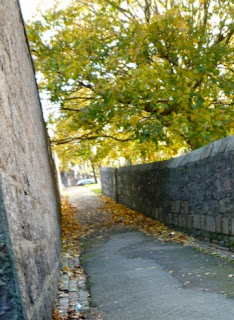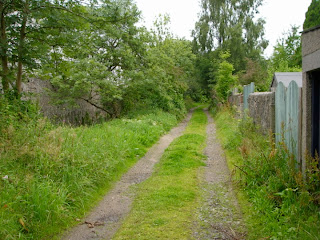It was a beautiful day, and the town was looking about as festive as it's possible to imagine Aberdeen looking; the snow lying generous and soft on roofs and boughs. I allowed myself the luxury of beginning to feel all lovely and Christmassy, full of goodwill to all men and such. That was my first mistake.
We've mentioned before that the top-deck of the Union Square multi-storey car-park is an interesting place where stunning panoramic views of the harbour, Torry, Ferryhill and the town centre are there to be enjoyed by anyone with eyes to see. Yesterday the freezing temperatures had cleared all the water vapour from the air, and the visibility was amazingly crisp and sharp. Realising that I'd not had any lunch, I bought a turkey & stuffing sandwich and a Curly-Wurly from Boots and decided to go up and eat them on the top-deck of the car-park. That was my second mistake.
Finishing my sandwiches and Curly-Wurly, and looking around, picking out familiar sky-line landmarks - Nigg Kirk, Ferrhyill House, Talisman House, St Clement's Kirk, Girdleness Lighthouse - I realised that I was completely alone. The top-deck was utterly deserted and silent. A strange feeling. Here, on one of the busiest shopping days of the year on top of the car-park of the most prime piece of retail real estate in the north of Scotland I found solitude, quiet, space, peace and fresh air. I felt liberated. That was my third mistake.
The desertion of the car park in the mid-afternoon early failing light was intriguing; loaded with content. The vacancy itself created a sort of highly-charged negative space, with the broad arching sky above and the white-covered town nestling this vacancy at its heart. I took a few photos, which I thought might be good for 'edgewatch'. That was my fourth mistake.
Amongst the photos I took was this one. That was my fifth mistake.
 |
| Who knew? That black hemisphere is a security camera. Watching me as I took this photo. |
After a few minutes and as I went to leave, a figure strode towards me across the deserted and snow-dusted concrete plain. As I drew closer and greeted him "hello there, what a spectacular afternoon!", I noticed that he was wearing a uniform. A smart-casual one, but in the ubiquitous polyester of the corporate issue paradigm. Oh-o. Then I noticed his two-way radio. Oh-o. Then he obstructed me and demanded to inspect my camera. I politely refused and tried to step around him. He obstructed me again and grabbed my arm. I asked him politely not to touch me, and to his credit he let go. Entering the stairhead, I went to leave. Four security guard petit-police were waiting for me on the landing. They blocked me from going down the stairs. I asked why. The one-in-charge said that he had orders to keep me there until the police arrived. I explained that I had taken photographs of the spectacular location and conditions. He told me that I could "explain that to the police". I asked why the police had been called. He said that they'd "had problems with this sort of thing before".
I was detained at close quarters by these men for about an hour. They refused to tell me what crime they suspected me of committing (one of them mumbled darkly of the Prevention of Terrorism Act), they refused to tell me by what authority they felt they could hold me against my will and they refused to allow me to leave. Close quarters detention at the hands of private enterprise petit-police; I was, in effect mini-kettled; surrounded by four well-build young men, one of whom continually shouted provocative taunts directly in my face whenever I tried to speak. They threatened to report me for assault if I were to try to push past them. They refused to allow me to use my phone. They prevented me from moving more than ten centimetres in any direction. I asked again what crime they suspected of committing. "You took a photo of a security camera". I asked whether that was a crime. I was shouted at and shouted down. It was affronting and humiliating.
Two Real Police officers arrived. A uniformed constable and a plain-clothes detective, both from the British Transport Police. I was subject to a PNC check, and the contents of my camera were inspected. I know that I would probably have been within my rights to refuse, but I had done nothing wrong; I had nothing to fear. The police confirmed this fact more-or-less immediately. While the uniformed officer was doing the PNC check I had a pleasant chat with the plain-clothes officer about alienation in the urban environment and the fascinating aesthetic appeal of certain aspects of functional urban space. It took a little while - he thought my taste was "weird" (he liked the Christmas-card-like photos I'd taken of Ferryhill's Marine Place - but initially couldn't see the appeal of the stark carparkscapes of Union Square) but eventually he 'got' it. He confirmed that I had done nothing wrong, and that I should complain to Union Square management about my treatment by the Security Guards. I probably can't be bothered doing that. Maybe I'll sent them a link to this post.
In the past, I've mentioned the 'Field Guide to Military Urbanism' blog. The blog mostly refers to urban situations in war zones, siege areas, divided communities and the like - but these words are pertinent to us, now, here:
I was detained at close quarters by these men for about an hour. They refused to tell me what crime they suspected me of committing (one of them mumbled darkly of the Prevention of Terrorism Act), they refused to tell me by what authority they felt they could hold me against my will and they refused to allow me to leave. Close quarters detention at the hands of private enterprise petit-police; I was, in effect mini-kettled; surrounded by four well-build young men, one of whom continually shouted provocative taunts directly in my face whenever I tried to speak. They threatened to report me for assault if I were to try to push past them. They refused to allow me to use my phone. They prevented me from moving more than ten centimetres in any direction. I asked again what crime they suspected of committing. "You took a photo of a security camera". I asked whether that was a crime. I was shouted at and shouted down. It was affronting and humiliating.
Two Real Police officers arrived. A uniformed constable and a plain-clothes detective, both from the British Transport Police. I was subject to a PNC check, and the contents of my camera were inspected. I know that I would probably have been within my rights to refuse, but I had done nothing wrong; I had nothing to fear. The police confirmed this fact more-or-less immediately. While the uniformed officer was doing the PNC check I had a pleasant chat with the plain-clothes officer about alienation in the urban environment and the fascinating aesthetic appeal of certain aspects of functional urban space. It took a little while - he thought my taste was "weird" (he liked the Christmas-card-like photos I'd taken of Ferryhill's Marine Place - but initially couldn't see the appeal of the stark carparkscapes of Union Square) but eventually he 'got' it. He confirmed that I had done nothing wrong, and that I should complain to Union Square management about my treatment by the Security Guards. I probably can't be bothered doing that. Maybe I'll sent them a link to this post.
In the past, I've mentioned the 'Field Guide to Military Urbanism' blog. The blog mostly refers to urban situations in war zones, siege areas, divided communities and the like - but these words are pertinent to us, now, here:
[The] contemporary city is defined by a kind of de facto psychopathology that is embodied in the very spaces and architectural rationales that order urbanization today, from gated communities to urban surveillance landscapes, to the last dying refuges of public space that have been [will be?] overwhelmed by privatization and a complete hyper securitization of the built environment at all scales.
One might ask... what is the current diagnosis and mental health state of western democracy? Or, how can the city be viewed as an architectural weapon to enforce behavior, to mandate neo-liberalism in a way, to turn a population into an obedient supporter of rampant commerce? What are the inherent narratives of power that run through spatial constructs like maximum-security prisons, shopping malls, refugee camps, suburban sprawl, and the hardened borderzones between nation-states? Is there a psychopathological connection between them? Is there a new urban archetype here to be deconstructed?
I was aware, of course that I was subject to surveillance - as we are at all times and in all spaces in any town centre. Yet when I was perceived to be sousveilling the surveillance mechanism I was detained and questioned. Why is it that when our image is captured by machines and people we cannot see, we feel that's OK - yet, when photos are taken of inanimate objects by a cheerful man who is obviously visible in plain view, this requires a response with overwhelming force?
My behaviour, as confirmed by the Real Police, was perfectly legal. I was committing no offence, I was harming no-one and no thing. Yet the private security operators of the shopping centre regard my behaviour as aberrant ("we've had problems with this sort of thing before"), a "problem", something to be stamped out.
The surveillance state was sold to us with the assurance: "If you're doing nothing wrong - then you've nothing to fear." We are not surprised that this statement has drifited into meaning "if you've done nothing outwith our arbitrarily-set code of conforming behaviour - then you've nothing to fear. Until our own paranoia and fear dictates that we arbitrarily change the rules."




















































